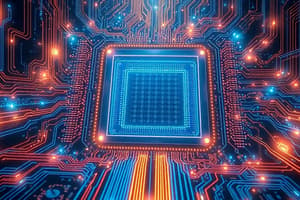Podcast
Questions and Answers
Pipelining is the process of arrangement of hardware elements of the ______ such that its overall performance is increased.
Pipelining is the process of arrangement of hardware elements of the ______ such that its overall performance is increased.
CPU
In pipelining, multiple instructions are overlapped in execution.
In pipelining, multiple instructions are overlapped in execution.
True (A)
Non-pipelined processors allow for simultaneous execution of multiple instructions.
Non-pipelined processors allow for simultaneous execution of multiple instructions.
False (B)
What is the primary challenge with pipelining in terms of performance?
What is the primary challenge with pipelining in terms of performance?
What does CPI stand for in the context of pipelining?
What does CPI stand for in the context of pipelining?
The ideal CPI in pipelining is 1, meaning one instruction is completed per clock cycle.
The ideal CPI in pipelining is 1, meaning one instruction is completed per clock cycle.
What is the general formula to calculate the number of instructions 'n' in a pipelined process, given 'k' stages and 'm' instructions?
What is the general formula to calculate the number of instructions 'n' in a pipelined process, given 'k' stages and 'm' instructions?
What is the general formula to calculate the speedup in a pipelined process?
What is the general formula to calculate the speedup in a pipelined process?
What is the general formula to calculate the efficiency or utilization in a pipelined process?
What is the general formula to calculate the efficiency or utilization in a pipelined process?
What are the three types of hazards that can occur in pipelining?
What are the three types of hazards that can occur in pipelining?
What is the core problem associated with hazards in pipelining?
What is the core problem associated with hazards in pipelining?
Data hazards occur when two or more instructions attempt to access the same resource at the same time.
Data hazards occur when two or more instructions attempt to access the same resource at the same time.
What is the core issue behind data hazards, specifically RAW (Read After Write) hazards?
What is the core issue behind data hazards, specifically RAW (Read After Write) hazards?
Structural hazards occur due to limited resources, including the CPU, memory, and registers, being accessed by multiple instructions simultaneously.
Structural hazards occur due to limited resources, including the CPU, memory, and registers, being accessed by multiple instructions simultaneously.
Control hazards are typically caused by conditional branch instructions, leading to uncertainties about the next instruction to be executed.
Control hazards are typically caused by conditional branch instructions, leading to uncertainties about the next instruction to be executed.
What common technique is used to address control hazards in pipelining?
What common technique is used to address control hazards in pipelining?
A stall in pipelining is a way of handling hazards by delaying the execution of one or more subsequent instructions until the hazard condition resolves.
A stall in pipelining is a way of handling hazards by delaying the execution of one or more subsequent instructions until the hazard condition resolves.
How does resource duplication help to address structural hazards in pipelining?
How does resource duplication help to address structural hazards in pipelining?
Although resource duplication solves structural hazards efficiently, it also increases the complexity of the overall system design.
Although resource duplication solves structural hazards efficiently, it also increases the complexity of the overall system design.
What is the key concept behind the simple solution to hazards in pipelining?
What is the key concept behind the simple solution to hazards in pipelining?
The goal of pipelining is to achieve a speedup in instruction execution, which can often be measured as the ratio of the number of instructions completed in the non-pipelined system versus the number of instructions completed in the pipelined system.
The goal of pipelining is to achieve a speedup in instruction execution, which can often be measured as the ratio of the number of instructions completed in the non-pipelined system versus the number of instructions completed in the pipelined system.
Flashcards
Pipelining
Pipelining
A technique used in CPUs to increase performance by overlapping the execution of multiple instructions.
Non-pipeline system
Non-pipeline system
A system where instructions must complete before the next one can begin, leading to slower processing.
Pipeline stages
Pipeline stages
Sequential steps in a pipeline, like instruction fetch, decode, execution, etc.
Instruction Fetch (IF)
Instruction Fetch (IF)
Signup and view all the flashcards
Instruction Decode (ID)
Instruction Decode (ID)
Signup and view all the flashcards
Operand Fetch (OF)
Operand Fetch (OF)
Signup and view all the flashcards
Execution (EX)
Execution (EX)
Signup and view all the flashcards
Memory Access (MEM)
Memory Access (MEM)
Signup and view all the flashcards
Write Back (WB)
Write Back (WB)
Signup and view all the flashcards
Data Hazard
Data Hazard
Signup and view all the flashcards
RAW Hazard
RAW Hazard
Signup and view all the flashcards
WAR Hazard
WAR Hazard
Signup and view all the flashcards
WAW Hazard
WAW Hazard
Signup and view all the flashcards
Structural Hazard
Structural Hazard
Signup and view all the flashcards
Control Hazard
Control Hazard
Signup and view all the flashcards
Pipelining Stages
Pipelining Stages
Signup and view all the flashcards
Speedup
Speedup
Signup and view all the flashcards
Efficiency
Efficiency
Signup and view all the flashcards
Hazard solutions
Hazard solutions
Signup and view all the flashcards
Clock Cycles
Clock Cycles
Signup and view all the flashcards
IPC
IPC
Signup and view all the flashcards
Study Notes
Pipelining Definition
- Pipelining is arranging CPU hardware elements to improve overall performance.
Pipelining Execution
- Pipelining allows simultaneous execution of multiple instructions.
- Non-pipelined processors execute instructions sequentially.
- Pipelining overlaps instruction execution for better performance.
Pipelining Stages
- Pipelining involves dividing instructions into stages (e.g., IF, ID, EX, MEM, WB).
- Instructions move through stages in an overlapping manner.
- Stages are performed sequentially for each instruction.
Pipelining Hazards
- Hazards, are problems that can slow down or stop pipeline execution.
- Data Hazards: occur when an instruction depends on the result of a prior instruction (e.g., Read After Write).
- Structural Hazards: arise when multiple instructions require the same hardware resources concurrently.
- Control Hazards: happen due to conditional branches or jumps in the program.
Hazard Solutions
- Resource duplication: providing multiple copies of shared hardware units can solve structural hazards.
Studying That Suits You
Use AI to generate personalized quizzes and flashcards to suit your learning preferences.




